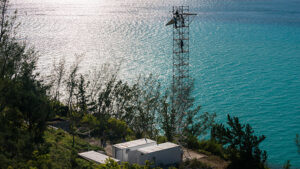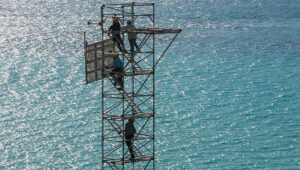Tudor Hill Observatory Being Outfitted for Next Chapter of Atmospheric Science

Renovated site and newly installed aluminum tower are being readied to resume monitoring projects.
“We hope it will be fully operational in the next couple of months,” said BIOS scientist Andrew Peters. This month he is installing the power cable, air sampling pumps and lines, filter housings, and meteorological sensors.
The Tudor Hill facility, run by Peters and supported by the National Science Foundation (NSF), is one of only a few marine atmospheric observatories that exist worldwide. It allows scientists to make year-round, complex measurements of particles and gases in the atmosphere over the ocean without the use of a research ship or buoy mooring. Since the original tower at Tudor Hill was built in 1988, it has hosted many international and collaborative efforts to study how particles and gasses journey over and interact with the ocean.
The new tower was donated to BIOS by University of Virginia research professor Bill Keene, who oversaw the installation. Eleven BIOS employees, including faculty and maintenance and science staff, gave their time to help with the installation over two days. This involved constructing sections of the tower, hauling them up manually using ropes and pulleys, and setting the guy wires to secure the structure. The NSF (Chemical Oceanography and Atmospheric Sciences sections) provided funding for the re-installation.
Interested in learning more about recent discoveries made at the Tudor Hill Observatory? This month, Andrew Peters and collaborators from Brown University and Princeton University published a study analyzing how much nitrogen pollution humans contribute to the ocean. Their results are far from what was previously believed.

Photo by Chris Burville
